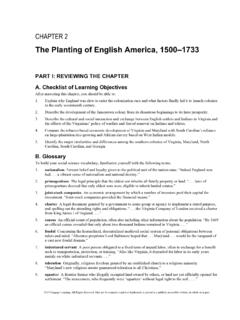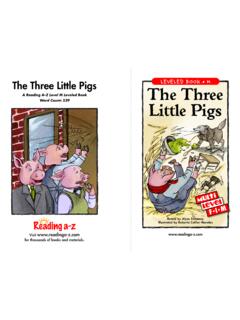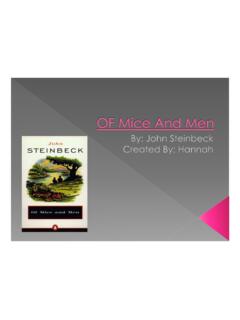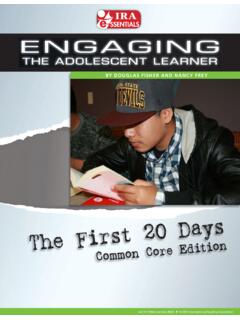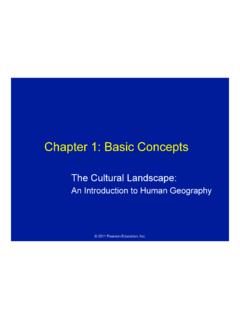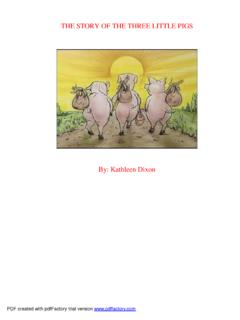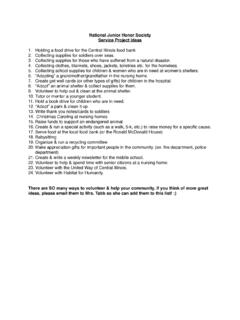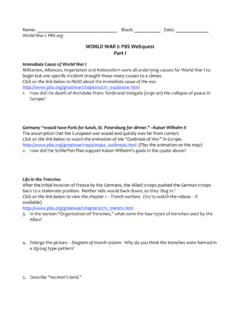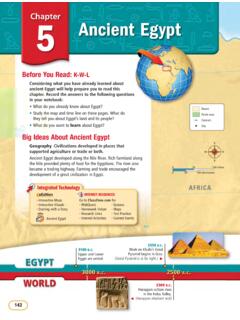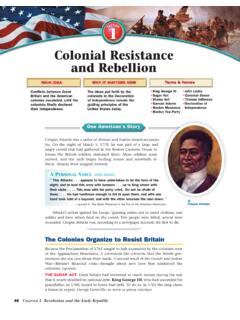Transcription of Feudalism in Europe
1 MAIN IDEAWHY IT MATTERS NOWTERMS & NAMESPOWER AND AUTHORITYF eudalism, a political andeconomic system based onland-holding and protectivealliances, emerges in Europe . The rights and duties of feudalrelationships helped shapetoday s forms of representativegovernment. lord fief vassal knight serf manor tithe2 Analyzing Causes andRecognizing EffectsUsea web diagramto show the causes and effectsof NOTESC auseCauseFeudalismEffectEffectSETTING THE STAGEA fter the Treaty of Verdun, Charlemagne s three feud-ing grandsons broke up the kingdom even further. Part of this territory alsobecame a battleground as new waves of invaders attacked Europe . The politicalturmoil and constant warfare led to the rise of European Feudalism , which, as youread in Chapter 2, is a political and economic system based on land ownershipand personal Attack Western EuropeFrom about 800 to 1000, invasions destroyed the Carolingian Empire.
2 Musliminvaders from the south seized Sicily and raided Italy. In 846, they sacked invaders struck from the east. Like the earlier Huns and Avars, they terrorized Germany and Italy. And from the north came the fearsome Vikings. The Vikings Invade from the NorthThe Vikings set sail from Scandinavia(SKAN duh NAY vee uh), a wintry, wooded region in Northern Europe . (Theregion is now the countries of Denmark, Norway, and Sweden.) The Vikings, alsocalled Northmen or Norsemen, were a Germanic people. They worshiped warlikegods and took pride in nicknames like Eric Bloodaxe and Thorfinn Vikings carried out their raids with terrifying speed.
3 Clutching swordsand heavy wooden shields, these helmeted seafarers beached their ships, struckquickly, and then moved out to sea again. They were gone before locals couldmount a defense. Viking warships were awe-inspiring. The largest of these longships held 300 warriors, who took turns rowing the ship s 72 oars. The prow ofeach ship swept grandly upward, often ending with the carved head of a sea mon-ster. A ship might weigh 20 tons when fully loaded. Yet, it could sail in a merethree feet of water. Rowing up shallow creeks, the Vikings looted inland villagesand in Europe A sketch of aViking longboat358 Chapter 13 The Vikings were not only warriors but also traders, farmers, and ventured far beyond western Europe .
4 Vikings journeyed down rivers into theheart of Russia, to Constantinople, and even across the icy waters of the NorthAtlantic. A Viking explorer named Leif (leef) Ericson reached North Americaaround 1000, almost 500 years before Columbus. About the same time, the Vikingreign of terror in Europe faded away. As Vikings gradually accepted Christianity,they stopped raiding monasteries. Also, a warming trend in Europe s climate madefarming easier in Scandinavia. As a result, fewer Scandinavians adopted the sea-faring life of Viking and Muslims Attack from the East and SouthAs Viking invasionsdeclined, Europe became the target of new assaults.
5 The Magyars, a group ofnomadic people, attacked from the east, from what is now Hungary. Superb horse-men, the Magyars swept across the plains of the Danube River and invaded west-ern Europe in the late 800s. They attacked isolated villages and monasteries. Theyoverran northern Italy and reached as far west as the Rhineland and Burgundy. TheMagyars did not settle conquered land. Instead, they took captives to sell as slaves. The Muslims struck from the south. They began their encroachments from theirstrongholds in North Africa, invading through what are now Italy and Spain. In the600s and 700s, the Muslim plan was to conquer and settle in Europe . By the 800sand 900s, their goal was also to plunder.
6 Because the Muslims were expert seafar-ers, they were able to attack settlements on the Atlantic and Mediterranean also struck as far inland as invasions by Vikings, Magyars, and Muslims caused widespread disorderand suffering. Most western Europeans lived in constant danger. Kings could notEuropean Middle Ages35942 N34 N8 W24 W16 W8 E16 E24 E32 E0 50 N58 N48 EMPIREFRANCECALIPHATEOF C RDOVAIRELANDENGLANDRUSSIASCANDINAVIAB urgundyRhinelandRomeGenoaPisaConstantino pleAachenKievParisTo u r sLondonTo 500 Miles 0 1,000 Kilometers Viking invasion routesViking areasMuslim invasion routesMuslim areasMagyar invasion routesMagyar areasInvasions in Europe , 700 1000 GEOGRAPHY skillbuilder : Interpreting Maps lands did the Vikings raid?
7 Were the Viking, Magyar, and Muslim invasions so threatening to Europe ?360 Chapter 13effectively defend their lands from invasion. As a result, people no longer lookedto a central ruler for security. Instead, many turned to local rulers who had theirown armies. Any leader who could fight the invaders gained followers and politi-cal strength. A New Social Order: FeudalismIn 911, two former enemies faced each other in a peace ceremony. Rollo was thehead of a Viking army. Rollo and his men had been plundering the rich Seine (sayn)River valley for years. Charles the Simple was the king of France but held littlepower. Charles granted the Viking leader a huge piece of French territory.
8 Itbecame known as Northmen s land, or Normandy. In return, Rollo swore a pledgeof loyalty to the king. Feudalism Structures Society The worst years of the invaders attacks spannedroughly 850 to 950. During this time, rulers and warriors like Charles and Rollo madesimilar agreements in many parts of Europe . The system of governing and landhold-ing, called Feudalism , had emerged in Europe . A similar feudal system existed inChina under the Zhou Dynasty, which ruled from around the 11th century in Japan began in and ended in the 19th feudal system was based on rights and obligations. In exchange for militaryprotection and other services, a lord, or landowner, granted land called a fief.
9 Theperson receiving a fiefwas called a vassal. Charles the Simple, the lord, and Rollo,the vassal, showed how this two-sided bargain worked. Feudalism depended on thecontrol of Feudal PyramidThe structure of feudal society was much like a pyramid. Atthe peak reigned the king. Next came the most powerful vassals wealthylandowners such as nobles and bishops. Serving beneath these vassals wereknights. Knightswere mounted horsemen who pledged to defend their lords landsin exchange for fiefs. At the base of the pyramid were landless peasants who toiledin the fields. (See Analyzing Key Concepts on next page.)Social Classes Are Well DefinedIn the feudal system, status determined a per-son s prestige and power.
10 Medieval writers classified people into three groups:those who fought (nobles and knights), those who prayed (men and women of theChurch), and those who worked (the peasants). Social class was usually Europe in the Middle Ages, the vast majority of people were peasants. Mostpeasants were serfs. Serfswere people who could not lawfully leave the place wherethey were born. Though bound to the land, serfs were not slaves. Their lords couldnot sell or buy them. But what their labor produced belonged to the : The Economic Side of FeudalismThe manorwas the lord s estate. During the Middle Ages, the manor system wasthe basic economic arrangement. The manor system rested on a set of rights andobligations between a lord and his serfs.
